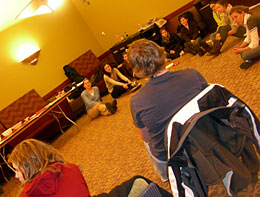Students gathered in the O’Connor Campus Center last week to engage in formal political discussion as part of a mock Democratic caucus.
With tensions running high between the Democratic presidential hopefuls, Sen. Hillary Rodham Clinton and Sen. Barack Obama, students hoped the caucus process would help them better understand the candidates and their platforms.
 |
| Students take part in a mock Democratic caucus at the Coop conference room. (Photo by Theodora Guliadis ’08) |
The Thursday night event was hosted by College Democrats of Colgate, whose members researched the process for hosting an actual caucus.
Sophomore Ashley Lazevnick said the group wanted to adhere to the strict rules in order to fully absorb the experience.
Co-president Lydia Gottesfeld ’08 said that through her preparation for the event, she learned how pivotal it is to “create concise, convincing arguments.”
Before the caucus began, a group member gave a brief history of the process and explained how it functions in contemporary campaigns.
Students split into three different groups, or “camps,” which included Clinton supporters, Obama supporters, and undecided voters.
Members of each camp had the opportunity to pose a question and then rebut the opposing side’s argument. Undecided voters were encouraged to ask questions to clarify illogical arguments and vague comments.
|
Upcoming Event Columnist George Will discuss the presidential campaign at 8 p.m. Thursday, March 27, at Memorial Chapel. His visit is sponsored by the Center for Freedom and Western Civilization. Colgate News • Get the latest stories sent by e-mail. |
The discussion grew throughout the evening and centered on the war in Iraq, the integrity of Clinton, and health care plans.
Gottesfeld said the passionate discussion showed that “people were not afraid to voice their opinions.”
“The caucus was small enough to engage in some great debate and big enough to have sufficient movement between the different groups,” said Gottesfeld.
Some students were swayed from one camp to another, proving that the exercise was valuable for all those who attended, she said.